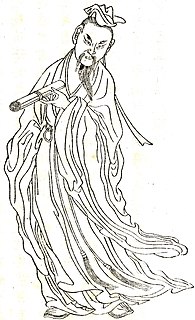Ban Gu
| Ban Gu | |
|---|---|

Ban Gu, 1st century AD Chinese poet, historian, and compiler of the Book of Han
|
|
| Born | AD 32 Anling, Fufeng County, Han Dynasty (now Xianyang, Shaanxi) |
| Died | AD 92 (aged 59–60) |
| Other names | Mengjian |
| Occupation | Historian |
| Known for | Book of Han |
| Relatives |
Ban Biao (father) Consort Ban (grand-aunt) Ban Chao (brother) Ban Zhao (sister) |
| Ban Gu | |||||||||||||||||||||||||||||||
| Chinese | 班固 | ||||||||||||||||||||||||||||||
|---|---|---|---|---|---|---|---|---|---|---|---|---|---|---|---|---|---|---|---|---|---|---|---|---|---|---|---|---|---|---|---|
|
|||||||||||||||||||||||||||||||
| Alternative Chinese name | |||||||||||||||||||||||||||||||
| Traditional Chinese | 孟堅 | ||||||||||||||||||||||||||||||
| Simplified Chinese | 孟坚 | ||||||||||||||||||||||||||||||
| Literal meaning | (courtesy name) | ||||||||||||||||||||||||||||||
|
|||||||||||||||||||||||||||||||
| Transcriptions | |
|---|---|
| Standard Mandarin | |
| Hanyu Pinyin | Bān Gù |
| Gwoyeu Romatzyh | Ban Guh |
| Wade–Giles | Pan1 Ku4 |
| IPA | [pán kû] |
| Yue: Cantonese | |
| Yale Romanization | Bāan Gu |
| Jyutping | Baan1 Gu3 |
| Southern Min | |
| Hokkien POJ | Pan Kòo |
| Middle Chinese | |
| Middle Chinese | Pæn Kù |
| Old Chinese | |
| Baxter-Sagart | *pˤ<r>an [k]ˤa-s |
| Transcriptions | |
|---|---|
| Standard Mandarin | |
| Hanyu Pinyin | Mèngjiān |
| Gwoyeu Romatzyh | Menqjian |
| Wade–Giles | Meng4-chien1 |
| Yue: Cantonese | |
| Yale Romanization | Maahng-gīn |
| Jyutping | Maang6-gin1 |
| Southern Min | |
| Hokkien POJ | Bīng-kian |
| Middle Chinese | |
| Middle Chinese | Mæ̀ng-ken |
| Old Chinese | |
| Baxter-Sagart | *mˤrang-s kˤin<g> |
Ban Gu (Chinese: 班固; AD 32–92) was an ancient Chinese historian and poet best known for his part in compiling the Book of Han, the second of China's 24 dynastic histories. He also wrote a number of fu, a major literary form, part prose and part poetry, which is particularly associated with the Han era. A number of Ban's fu were collected by Xiao Tong in the Wen Xuan.
The Ban family was one of the most distinguished families of the Eastern Han dynasty. They lived in the state of Chu during the Warring States period, but in the 3rd century BC, a man named Ban Yi moved north to Loufen (modern Yanmenguan, Shanxi Province). By the early Han Dynasty, Ban Gu's ancestors gained prominence on the northwestern frontier as herders of several thousand cattle, oxen, and horses, which they traded in a formidable business and encouraged other families to move to the frontier. Ban Biao later moved the family to Anling (near modern Xianyang, Shaanxi).
Ban Gu's great-aunt Consort Ban was a scholar and poet, and his father Ban Biao was a prominent historian. He took over from his father responsibility for writing a history of the former Han Dynasty, a book known in modern times as the Hanshu or Book of Han. However, his work was interrupted by political problems, as his association with the family of Empress Dowager Dou led to his imprisonment and death (either by execution or torture). A few volumes of his book in 13–20th (eight chronological charts) and 26th (astronomical biography), however, was completed by his younger sister, Ban Zhao, and became a model for many other works about later dynasties.
...
Wikipedia
